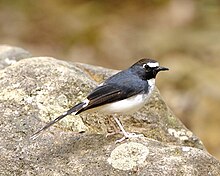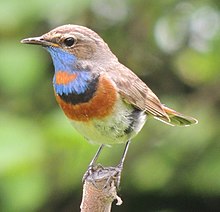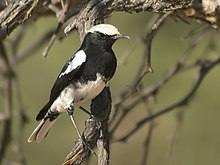Schmätzer
| Schmätzer | ||||||||||||
|---|---|---|---|---|---|---|---|---|---|---|---|---|

Wheatear ( Oenanthe oenanthe ) |
||||||||||||
| Systematics | ||||||||||||
|
||||||||||||
| Scientific name | ||||||||||||
| Saxicolinae | ||||||||||||
| Vigors , 1825 |
The Schmätzer (Saxicolinae) are a subfamily of the flycatcher family (Muscicapidae) within the passerine birds (Passeriformes). The Schmätzer were traditionally assigned to the thrush family (Turdidae). Molecular genetic findings suggest, however, that the Schmätzer are more closely related to the flycatchers.
The Schmätzer are common in the Old World and feed primarily on insects . Most species are native to the tropics and subtropics of Africa and Southeast Asia. The genera, which also occur in Europe, are informally grouped together as the common warbler (Erithacinae). These include Nightingale and relatives ( Luscinia ), redstarts ( Phoenicurus ), Blue Dicks ( Tarsiger ), meadows and wheatear ( Saxicola and Oenanthe ). Sometimes all representatives of the subfamily are referred to as earth singers.
description
The Schmätzer are a little uniform group of relatively small species, which often have a very colorful plumage and slender legs. The song is well developed in some species, but poor in others. According to the insectivore diet, the beak is dainty and slender, in some species beak bristles are developed. The males of some species - for example the black redstart - show a delayed plumage maturation and look like females in the first year of life, although they are already sexually mature.
Systematics
The Schmätzer were traditionally assigned to the thrush family (Turdidae) and placed there as a subfamily next to the real thrushes . However, the findings of DNA hybridization as well as more recent results of the sequencing of the mitochondrial cytochrome b gene suggest that the Schmätzer are more closely related to the flycatchers (Muscicapidae) than to the thrushes.
The subdivision of the flycatcher family into the actual flycatcher (Muscicapinae) and the Schmätzer (Saxicolinae) currently seems somewhat artificial, some genera seem to be closer to the genera of the other subfamily, possibly the internal system of the flycatchers needs a fundamental revision, if all Relationships are clarified.
The following presentation of the genera essentially follows the Handbook of the Birds of the World , supplemented by the results of more recent molecular genetic studies. These establish that some genera previously assigned to thrushes ( Monticola , Myophonus and Brachypteryx ) are closer to the smackers and the Asian genera Grandala and Cochoa , which were at times attributed to the smackers , are closer to the thrushes.
Genera and species
The subfamily includes about 25 genera and 170 species.
-
Brachypteryx - 3 species
- Red-bellied short-winged ( Brachypteryx hyperythra )
- Dwarf flying wing ( Brachypteryx leucophrys )
- Mountain flare ( Brachypteryx montana )

-
Calliope - 5 types
- Ruby throat ( Calliope calliope )
- Mountain Rubin throat ( Calliope pectoralis )
- Tibetan Rubin throat ( Calliope tschebaiewi )
- Fire- throated nightingale ( Calliope pectardens )
- Black-throated nightingale ( Calliope obscura )
-
Campicoloides - 1 kind
- Pale shoulder ginger ( Campicoloides bifasciatus )
-
Cinclidium - 1 kind
- Blue treasure ( Cinclidium frontale )
-
Emarginata - 3 species
- Bleichschmätzer ( emarginata schlegelii )
- Sickle- winged chatterbox ( Emarginata sinuata )
- Oranjeschmätzer ( Emarginata tractrac )

-
Scissortails ( Enicurus ) - 8 species
- Borneo scissorstail ( Enicurus borneensis )
- Black-backed scissorstail ( Enicurus immaculatus )
- White-parted Scissorstail ( Enicurus leschenaulti )
- Spotted scissors tail ( Enicurus maculatus )
- Redhead scissorstail ( Enicurus ruficapillus )
- Gray-backed scissorstail ( Enicurus schistaceus )
- Stubby tail ( Enicurus scouleri )
- Dwarf scissors tail ( Enicurus velatus )


-
Cave flycatcher ( Ficedula ) - 31 species
- Taiga dwarf flycatcher ( Ficedula albicilla )
- Collared Flycatcher ( Ficedula albicollis )
- Slate groundcatcher ( Ficedula basilanica )
- Bonthain groundcatcher ( Ficedula bonthaina )
- Moluccan ground flycatcher ( Ficedula buruensis )
- Philippines groundcatcher ( Ficedula crypta )
- Luzon ground flycatcher ( Ficedula disposita )
- Mirror flycatcher ( Ficedula dumetoria )
- Daffodil-elisae ( Ficedula elisae )
- Sumba groundcatcher ( Ficedula harterti )
- Spotted Ground Flycatcher ( Ficedula henrici )
- Spruce flycatcher ( Ficedula hodgsonii )
- Red-breasted ground flycatcher ( Ficedula hyperythra )
- Pied flycatcher ( Ficedula hypoleuca )
- Mugimaki flycatcher ( Ficedula Mugimaki )
- Daffodil flycatcher ( Ficedula narcissina )
- Ficedula nigrorufa
- Miniature Flycatcher ( Ficedula parva )
- Palawan catcher ( Ficedula platenae )
- Ficedula riedeli
- Celebes groundcatcher ( Ficedula rufigula )
- Ficedula sapphira
- Half-ring flycatcher ( Ficedula semitorquata )
- Atlas flycatcher ( Ficedula speculigera )
- Cinnamon-throated flycatcher ( Ficedula strophiata )
- Cashmere dwarf flycatcher ( Ficedula subrubra )
- Browcatcher ( Ficedula superciliaris )
- Chest-band groundcatcher ( Ficedula timorensis )
- Ficedula tricolor
- Magpie flycatcher ( Ficedula westermanni )
- Korean goldcatcher ( Ficedula zanthopygia )
-
Heinrichia - 1 Art
- Celebes wing ( Heinrichia calligyna )
-
Heteroxenicus - 1 species
- Brown-backed short-winged ( Heteroxenicus stellatus )
-
Irania - 1 Art
- White-throated Warbler ( Irania gutturalis )

-
Larvivora - 6 species
- Rostkehlnachtingall ( Erithacus akahige )
- Orange eightingale ( Larvivora brunnea )
- Blue nightingale ( Larvivora cyane )
- Velvet-throated nightingale ( Erithacus komadori )
- Redheaded Nightingale ( Larvivora ruficeps )
- Buzzing nightingale ( Larvivora sibilans )
-
Leonardina - 1 item
- Mindanao Island Thrush ( Leonardina woodi )

-
Luscinia - 4 types
- Sprout ( Luscinia luscinia )
- Nightingale ( Luscinia megarhynchos )
- White-bellied rusttail ( Luscinia phaenicuroides )
- Bluethroat ( Luscinia svecica )

-
Red chalk ( Monticola ) - 13 species
- Miomborötel ( Monticola angolensis )
- Short-toed red chalk ( Monticola brevipes )
- Bergrötel ( Monti Cola cinclorhynchus )
- Long-toe red chalk ( Monticola explorator )
- Amur chalk ( Monticola gularis )
- Red chalk ( Monticola imerina )
- Red Marble ( Monticola rufiventris )
- Canyon red chalk ( Monticola rufocinereus )
- Red chalk ( Monticola rupestris )
- Red chalk ( Monticola saxatilis )
-
Rötel ( Monticola sharpei )
- Ambrerötel ( Monticola sharpei erythronotus )
- Blue Alder ( Monticola solitarius )
-
Muscicapella - 1 type
- Golden-winged bluecatcher ( Muscicapella hodgsoni )
-
Myiomela - 2 types
- Diadem wheatear ( Myiomela diana )
- Shadow treasurer ( Myiomela leucura )
-
Whistling thrushes ( Myophonus ) - 9 species
- Ceylon whistling thrush ( Myophonus blighi )
- Borneopfeifdrossel ( Myophonus borneensis )
- Purple Whistling Thrush ( Myophonus caeruleus )
- Sumatran butterfly ( Myophonus castaneus )
- Java Whistle Thrush ( Myophonus glaucinus )
- Malabarpfeifdrossel ( Myophonus horsfieldii )
- Taiwan whistling thrush ( Myophonus insularis )
- Whistling Thrush ( Myophonus melanurus )
- Common Whistle Thrush ( Myophonus robinsoni )

-
Myrmecocichla - 8 species
- Black wheatear ( Myrmecocichla aethiops )
- White fronted wheatear ( Myrmecocichla albifrons )
- Arnot wheatear ( Myrmecocichla arnotti )
- Termite lover ( Myrmecocichla formicivora )
- White wheatear ( Myrmecocichla melaena )
- Mountain wheatear ( Myrmecocichla monticola )
- Hades chatterer ( Myrmecocichla nigra )
- Congo appraiser ( Myrmecocichla tholloni )


-
Wheatear ( Oenanthe ) - 28 species
- White-fronted wheatear ( Oenanthe albifrons )
- Black head wheatear ( Oenanthe albonigra )
- Brown breast wheatear ( Oenanthe bottae )
- Red-tailed wheatear ( Oenanthe chrysopygia )
- Desert wheatear ( Oenanthe deserti )
- Wheatear ( Oenanthe dubia )
- Rusttail ( Oenanthe familiaris )
- Rock talker ( Oenanthe finschii )
- Black-backed wheatear ( Oenanthe halophila )
- Brown sausage ( Oenanthe fusca )
- Heuglin wheatear ( Oenanthe heuglini )
- Mediterranean wheatear ( Oenanthe hispanica )
- Wheatear ( Oenanthe isabellina )
- Saharan wheatear ( Oenanthe leucopyga )
- Black wheatear ( Oenanthe leucura )
- Black- backed ginger ( Oenanthe lugens )
- Arabian wheatear ( Oenanthe lugentoides )
- Rüppel wheatear ( Oenanthe lugubris )
- Blacktail ( Oenanthe melanura )
- White wheatear ( Oenanthe moesta )
- Capstone wheatear ( Oenanthe monacha )
- Wheatear ( Oenanthe oenanthe )
- Somali wheatear ( Oenanthe phillipsi )
- Elsterschmätzer ( Oenanthe picata )
- Common wheatear ( Oenanthe pileata )
- Nonnenschmätzer ( Oenanthe pleschanka )
- Brown tail ( Oenanthe scotocerca )
- Rusty wheatear ( Oenanthe xanthoprymna )

-
Redstart ( Phoenicurus ) - 12 species
- Rust-throated redstart ( Phoenicurus alaschanicus )
- Spiegelrotschwanz ( Phoenicurus auroreus )
- Luzon red chalk ( Phoenicurus bicolor )
- Blue head Rotschwanz ( Phoenicurus caeruleocephala )
- Giant redstart ( Phoenicurus erythrogastrus )
- Redstart ( Phoenicurus erythronotus )
- Himalayan redtail ( Phoenicurus frontalis )
- Red chalk ( Phoenicurus fuliginosa )
- European redstart ( Phoenicurus hodgsoni )
- White-crowned redstart ( Phoenicurus leucocephalus )
- Diadem redstart ( Phoenicurus moussieri )
- Black redstart ( Phoenicurus ochruros )
- Common redstart ( Phoenicurus phoenicurus )
- Redstart ( Phoenicurus schisticeps )
-
Pinarochroa - 1 type
- Almenschmätzer ( Pinarochroa sordida )
-
Pinarornis - 1 kind
- Stein Springer ( Pinarornis plumosus )

-
Meadow treacherous ( Saxicola ) - 15 species
- Mohrenschwarzkehlchen ( Saxicola caprata )
- Canary treacherous ( Saxicola dacotiae )
- Gray valer ( Saxicola ferreus )
- Timor wheatear ( Saxicola gutturalis )
- Mat treacherous ( Saxicola insignis )
- Jerdon Schmätzer ( Saxicola jerdoni )
- White-tailed stonechat ( Saxicola leucurus )
- Common Whinchat ( Saxicola macrorhynchus )
- Siberian stonechat ( Saxicola maurus )
- Whinchat ( Saxicola rubetra )
- Stonechat ( Saxicola rubicola )
- Madagascar stonechat ( Saxicola sibilla )
- Stejneger's stonechat ( Saxicola stejnegeri )
- Reunion black throat ( Saxicola tectes )
- African stonechat ( Saxicola torquatus )
-
Sholicola - 2 types
- White-bellied wheatear ( Sholicola albiventris )
- Nilgirischmätzer ( Sholicola major )

-
Tarsiger - 6 types
- Gold tail ( Tarsiger chrysaeus )
- Blue-tailed ( Tarsiger cyanurus )
- Rust-breasted blue-tail ( Tarsiger hyperythrus )
- White-browed blue-tail ( Tarsiger indicus )
- Taiwan Blue Tail ( Tarsiger johnstoniae )
- Himalayan blue tail ( Tarsiger rufilatus )
-
Thamnolaea - 2 species
- Red-bellied wheatear ( Thamnolaea cinnamomeiventris )
- White Crowned Whelk ( Thamnolaea coronata )
-
Vauriella - 4 types
- Negrosdschungelschnäpper ( Vauriella albigularis )
- Gray-backed jungle flycatcher ( Vauriella goodfellowi )
- White- browed jungle flycatcher ( Vauriella gularis )
- Red flank jungle flycatcher ( Vauriella insignis )
literature
- Josep del Hoyo , Andrew Elliott, David A. Christie: Handbook of the Birds of the World. Volume 10: Cuckoo-shrikes to Thrushes. Lynx Edicions, Barcelona 2005, ISBN 978-84-87334-72-6 .
- Urs N. Glutz von Blotzheim , KM Bauer : Handbook of the birds of Central Europe (HBV). Volume 11 / I: Schmätzer and relatives: Erithacinae. AULA-Verlag, ISBN 3-923527-00-4 .
- Armin Landmann: The black redstart . AULA-Verlag, Wiesbaden 1996, ISBN 3-89104-551-4
Individual evidence
- ↑ a b HBV Volume 11 / I, page 14f, see literature
- ↑ Armin Landmann: The black redstart . Page 10f, see literature
- ↑ zipcodezoo.com: Muscicapidae ( Memento from June 14, 2010 in the Internet Archive )
- ^ Gary Voelker, Garth M. Spellman: Nuclear and mitochondrial DNA evidence of polyphyly in the avian superfamily Muscicapoidea . In: Molecular Phylogenetics and Evolution , 30 (2): 386-394, February 2004. doi : 10.1016 / S1055-7903 (03) 00191-X .
